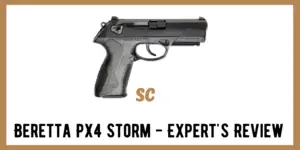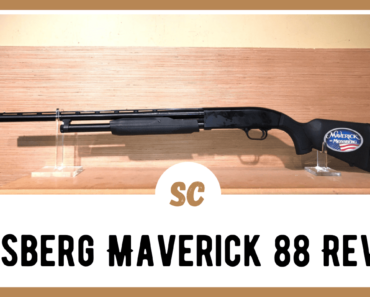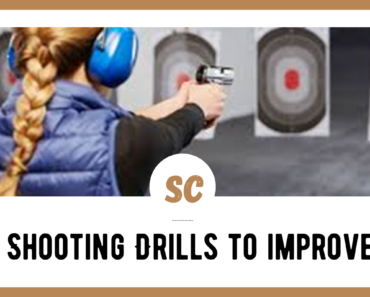The first pistol I bought for myself as a self-defense concealed carry firearm was a Beretta 70 Series pistol chambered for .380.
To be quite honest, I didn’t like that gun and only kept it for a few years. I have tried Beretta pistols off and on over the years. After shooting the PX4 Storm, I may have to change my opinion of Beretta pistols.
The hallmark of the Beretta PX4 Storm is the rotating barrel design. Beretta claims that this design lessens felt recoil energy and creates reduced muzzle flip. In addition, the PX4 Storm uses the same trigger and safety system as the Beretta 92, so its operation will be familiar to many shooters.
The Beretta PX4 Storm is a modern polymer frame semi-automatic pistol in all regards. Berretta designed this pistol for self-defense and law enforcement use. It is apparent that Beretta adopted the form-follows-function concept as, in my eye, they made no attempt to create a visual impact. To me, this gun is just plain ugly.
The Beretta PX4 Storm Lineup – Understanding the Nomenclature
Beretta produces four models of the PX4 Storm pistol. These different models share the same basic design and underlying features. The differences are mostly in the pistol operating action. The found models of Beretta PX4 Storm include the following:
Type C
Type C PX4 Storm pistols are single-action only. Beretta terms the ready state as “constant action where the hammer rides in a half-cock position. The hammer is spurless. The Type C pistols have no decocker and no manual safety.
Type D
If you opt for a Type D Beretta PX4 Storm you will get a double-action-only semi-auto pistol. This model features a spurless hammer, no decocker, and no manual safety.
Type F
The most common model of the Beretta PX4 Storm found in the American market is the Type F. These pistols operate in both single and double-action mode and include a decocker and a manual safety.
Type G
Almost as popular is the Type G Beretta PX4 Storm. This model also operates in both single and double-action modes. You will find a decocker on these pistols, but no manual safety.
Variants and Styles
Beretta produces a wide variety of different styles and variations on the PX4 Storm line of pistols. In general, these variations and styles offer shooters more customized pistols than the basic PX4 Storm lineup. Some of the variations and styles from which you can choose include these options:
- PX4 Storm Compact and subcompact variants
- PX4 Storm Full-Size and full-size variants
- PX4 Storm Compact Carry
- PX4 Storm Carry
Some of these variations also can be bought in different color schemes including flat dark earth, grey, and a contracting model with a stainless slide and black frame.
Specifications
To keep the technical folks happy, let’s start with the technical specifications of the basic Beretta PX4 Storm full-size pistol.
The dimensions of the variants will change, but the specifications on the full-size model of the PX4 Storm give us an overall view of the firearm.
- Barrel length – 4 inches
- Available Calibers – .40 S&W, .45 Auto, 9×19 PARA, 9×21 IMI
- Magazine Capacity – 14 rounds
- Height Overall – 5.51 inches
- Length Overall – 7.5 inches
- Width – 1.42 inches
- Sight Radius – 6.02 inches
- Weight (unloaded) – 27.7 ounces
The Beretta PX4 Storm is a hefty pistol. For some people, the dimensions of even the compact variants may make concealed carry difficult. However, the extra size on the grip and the weight of the gun overall can be an advantage in controlling recoil energy and muzzle flip when shooting.
Beretta PX4 Storm Features
- NATO Certified
- Snag-free modular design
- Integral Picatinny rail forward of the trigger guard
- Interchangeable grip backstraps to customize hand fit
- Ambidextrous and reversible controls
- Cold-hammer-forged barrel and steel bearing surfaces in the polymer frame
- A lower barrel axis on the rotating barrel locking system works by releasing recoil energy radially instead of back to the shooter’s arm and hand
- 3-dot sight system adjustable for windage for quick sight acquisition
Some of the other compact and subcompact variants have slightly different feature lists. These can differ based on the type, model, and configuration of the options you select for your Beretta PX4 Storm pistol.
The Modular Components of the PX4 Semi-Auto Pistol
Beretta touts the modular design of the Storm PX4 for its simplicity and reduced number of moving parts. This particular weapon is based around a fiberglass-reinforced polymer frame with steel inserts on the bearing surfaces.
Let’s look at each of the components in this modular design semi-auto pistol.
The Frame
Beretta starts with a fiberglass-reinforced polymer frame. All of the bearing surfaces where the slide rides are steel-reinforced for longevity and durability. The frame is designed to put all the controls within easy reach of your hand without changing your grip during firing. Overall, the frame feels substantial and stiff.
The Slide
The slide on the PX4 Storm is machined from alloy steel and is quite hefty. The top of the slide is flat, unlike many other semi-automatic pistols. The sights are set as far apart as possible on the slide to give the maximum sight radius. The slide has forward and rear serrations machined on the slide.
The Barrel
The barrel and the barrel action are where Beretta departs from the traditional design of their pistol. Most other pistols in this class use the usual browning action with a tilt barrel system. Beretta chose to use a rotating barrel and locking system. This gives several advantages, according to Beretta.
One of those advantages is that the rotating barrel helps control muzzle flip and felt recoil.
I don’t know if there is any measurable truth to the rotating barrel absorbing recoil through the rotary action. However, this rotating barrel design does allow the barrel axis to sit slightly lower in the frame, which should make a difference in felt recoil.
Additionally, muzzle rise when shooting the Beretta PX4 seems to be reduced.
I did find it easy to keep a target in view of the sights when shooting at the range. There might be an argument for better weapon control with the rotating barrel design. The full-size models feature a 4-inch barrel length.
The Trigger
One major problem I have with DA/SA pistols is managing the different trigger pulls my trigger finger must learn depending on which mode is active. This is a normal problem with any pistol that operates as a DA/SA trigger system.
In double-action mode, the trigger pull of the PX4 is not excessively heavy. However, I did find the reset travel very long. As a single-action trigger system, the take-up seemed a little long, but the trigger break was clean and crisp with no creep.
Pistol Controls
I found the other pistol controls on the Beretta Storm well designed and properly placed with a couple of exceptions. For concealed carry, the ambidextrous safety makes the overall width of the pistol excessive in my view. The lever on the safety could have been smaller and been just as effective.
The magazine release button is easy to locate and operates smoothly. It is a bit small, but once you are used to the location and size, it seems to fall automatically under your finger when it is time to drop a magazine. All of my mag drops were smooth and without problems.
My Conclusions
All in all, I think that Beretta has scored a major achievement with the PX4 Storm.
There are some things I would do differently. I would replace factory sights with fiber optic night sights, especially if I were carrying this as a duty pistol. I would also add more stippling to the grip and frame. The grip feels cheap to me. Otherwise, I found the Beretta PX4 Storm to be a well-designed, rugged, and functional pistol that is a very accurate firearm.












![[VIDEO] Transforming a Light Medium Tactical Vehicle into a mobile home – Part 1 [VIDEO] Transforming a Light Medium Tactical Vehicle into a mobile home – Part 1](https://survivalcove.com/wp-content/uploads/2022/11/article-LMTV_edited-370x297.png)
























